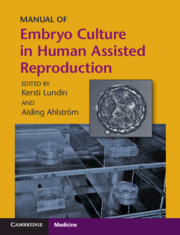Book contents
- Manual of Embryo Culture in Human Assisted Reproduction
- Cambridge Laboratory Manuals in Assisted Reproductive Technology
- Manual of Embryo Culture in Human Assisted Reproduction
- Copyright page
- Contents
- Contributors
- Preface
- Chapter 1 Facilities for Embryo Culture
- Chapter 2 Incubators for Embryo Culture
- Chapter 3 Consumables for the IVF Laboratory
- Chapter 4 Embryo Metabolism and What Does the Embryo Need?
- Chapter 5 Culture Media and Embryo Culture
- Chapter 6 Optimal Handling Techniques for Culture of Human Embryos
- Chapter 7 From Identification to Witnessing
- Chapter 8 Timing of Embryo Culture
- Chapter 9 Time-Lapse Technology
- Chapter 10 Laboratory Monitoring for Embryo Culture
- Chapter 11 Embryo Culture and IVF Offspring Outcome
- Chapter 12 The Changing Culture of Embryo Culture
- Index
- Plate Section (PDF Only)
- References
Chapter 10 - Laboratory Monitoring for Embryo Culture
Published online by Cambridge University Press: 15 April 2021
- Manual of Embryo Culture in Human Assisted Reproduction
- Cambridge Laboratory Manuals in Assisted Reproductive Technology
- Manual of Embryo Culture in Human Assisted Reproduction
- Copyright page
- Contents
- Contributors
- Preface
- Chapter 1 Facilities for Embryo Culture
- Chapter 2 Incubators for Embryo Culture
- Chapter 3 Consumables for the IVF Laboratory
- Chapter 4 Embryo Metabolism and What Does the Embryo Need?
- Chapter 5 Culture Media and Embryo Culture
- Chapter 6 Optimal Handling Techniques for Culture of Human Embryos
- Chapter 7 From Identification to Witnessing
- Chapter 8 Timing of Embryo Culture
- Chapter 9 Time-Lapse Technology
- Chapter 10 Laboratory Monitoring for Embryo Culture
- Chapter 11 Embryo Culture and IVF Offspring Outcome
- Chapter 12 The Changing Culture of Embryo Culture
- Index
- Plate Section (PDF Only)
- References
Summary
The IVF laboratory is central to Medically Assisted Reproduction perhaps representing also the most crucial extrinsic factor in determining success or failure of treatment. Current science and technology are unable to improve the intrinsic developmental potential of gametes. Therefore, the “mission” of the IVF laboratory consists in the ability to preserve the innate characteristics of sperm and oocytes in the course of preimplantation development and minimize the possible detrimental impact of diverse forms of manipulation. To this end, during culture and manipulation, physical factors (e.g., temperature, atmosphere composition) and stressors (e.g., oocyte microinjection, embryo biopsy) should be monitored and controlled, in order to guarantee stability of conditions considered to be the most appropriate to support and facilitate gamete and embryo function in vitro. In this scenario, the human factor and effectiveness of technical equipment contribute in similar or equivalent proportions in determining clinical outcome. In light of this, not only is monitoring of working conditions of equipment important, but objective assessment of key segments of the IVF process is vital. Performance indicators respond to this need, offering specific, important, and objective measurements of essential processes, such as fertilization, development to blastocyst stage, and cryopreservation. Thus, critical analysis and interpretation of indicators can lead to consistency of results and continued improvement.
- Type
- Chapter
- Information
- Manual of Embryo Culture in Human Assisted Reproduction , pp. 84 - 91Publisher: Cambridge University PressPrint publication year: 2021

